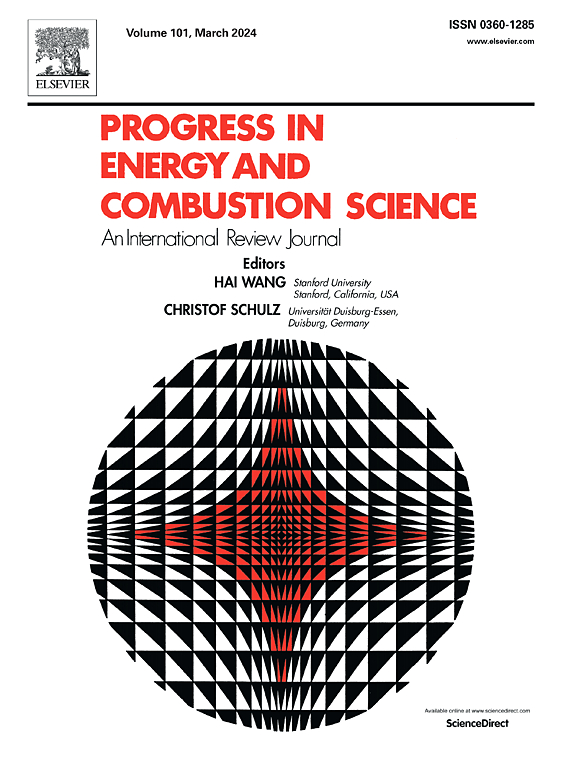Flame spread over solid materials under reduced buoyancy/gravity
IF 37
1区 工程技术
Q1 ENERGY & FUELS
引用次数: 0
Abstract
Space exploration is a shared human aspiration that presents significant challenges, with fire being a major threat. The unique low-gravity, reduced-buoyancy environments of spacecraft and extraterrestrial habitats profoundly alter fluid dynamics, chemical reactions, and heat-mass transfer, leading to drastic changes in fire behavior. Understanding the solid material combustion under these conditions is vital for spacecraft fire safety and advances fundamental combustion science. This review synthesizes research on flame spread over solid materials under reduced buoyancy/gravity over the past half-century. It uniquely integrates the studies conducted in micro- and partial-gravities with ground-based experiments designed to mimic these environments. The review begins with the theoretical models defining the flame behavior and examines experimental findings from low gravities. These results reveal the important roles of “smothering” effects and radiative heat loss due to the suppressed natural convection, which drive a transition from two-dimensional to three-dimensional flame structures. Ground-based simulation methodologies, including reduced pressure environments and narrow channel apparatus, are critically examined for their ability to replicate low gravities. Stagnation point low-stretch diffusion flames are also included as a ground-based method to simulate the reduced-buoyancy effects on the spreading flame front from a more microscopic perspective. By comparing actual low-gravity data with simulated environments, the review introduces key similarity laws but also discusses the limitations of these methods in fully capturing low-gravity combustion dynamics. As the first integrated review of this topic, this work provides essential insights for ensuring the fire safety of human space exploration in the decades to come.
在浮力/重力降低的情况下,火焰在固体材料上蔓延
太空探索是人类共同的愿望,它带来了重大挑战,其中火灾是主要威胁。航天器和地外栖息地独特的低重力、低浮力环境深刻地改变了流体动力学、化学反应和热质传递,导致火灾行为的剧烈变化。了解固体材料在这些条件下的燃烧对航天器的消防安全至关重要,并推动基础燃烧科学的发展。本文综述了近半个世纪以来在降低浮力/重力条件下火焰在固体材料上传播的研究。它独特地将在微重力和部分重力中进行的研究与旨在模拟这些环境的地面实验结合起来。回顾从定义火焰行为的理论模型开始,并检查低重力下的实验结果。这些结果揭示了“窒息”效应和自然对流抑制导致的辐射热损失在火焰结构从二维向三维转变中的重要作用。地面模拟方法,包括减压环境和窄通道设备,都严格检查了它们复制低重力的能力。还包括驻点低拉伸扩散火焰作为地基方法,从更微观的角度模拟火焰前缘的减浮力效应。通过比较实际的低重力数据和模拟环境,本文介绍了关键的相似定律,但也讨论了这些方法在完全捕获低重力燃烧动力学方面的局限性。作为对这一主题的首次综合审查,这项工作为确保未来几十年人类太空探索的消防安全提供了重要的见解。
本文章由计算机程序翻译,如有差异,请以英文原文为准。
求助全文
约1分钟内获得全文
求助全文
来源期刊

Progress in Energy and Combustion Science
工程技术-工程:化工
CiteScore
59.30
自引率
0.70%
发文量
44
审稿时长
3 months
期刊介绍:
Progress in Energy and Combustion Science (PECS) publishes review articles covering all aspects of energy and combustion science. These articles offer a comprehensive, in-depth overview, evaluation, and discussion of specific topics. Given the importance of climate change and energy conservation, efficient combustion of fossil fuels and the development of sustainable energy systems are emphasized. Environmental protection requires limiting pollutants, including greenhouse gases, emitted from combustion and other energy-intensive systems. Additionally, combustion plays a vital role in process technology and materials science.
PECS features articles authored by internationally recognized experts in combustion, flames, fuel science and technology, and sustainable energy solutions. Each volume includes specially commissioned review articles providing orderly and concise surveys and scientific discussions on various aspects of combustion and energy. While not overly lengthy, these articles allow authors to thoroughly and comprehensively explore their subjects. They serve as valuable resources for researchers seeking knowledge beyond their own fields and for students and engineers in government and industrial research seeking comprehensive reviews and practical solutions.
 求助内容:
求助内容: 应助结果提醒方式:
应助结果提醒方式:


